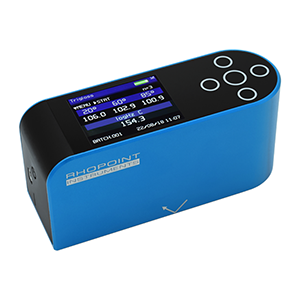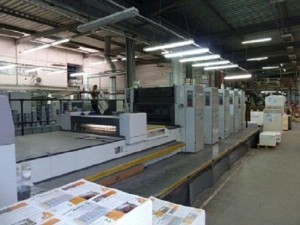Aqueous coatings ( water-based varnishes) are used from commercial printers for a long time giving benefits to final product and to printers in a way of higher gloss of printed product, better rub resistance, smoother feel (elimination or reduction of spray powder), and faster handling of the printed work.
Basic Properties
GLOSS– is used when we need to express the ability of surface to reflect direct light. Gloss meters are used to measure reflected light from the surface at various angles, typically 20, 60 and 85. The number represents the percentage of light reflected from the printed surface. The higher the number, the glossier the surface.

Most printers measure lithographic printed and water-based coated gloss at 60 degrees. Typical values are tabulated below:
60 Degree Gloss
SBS Stock [unprinted] 10-20
Low Gloss [satin, matte, dull] 10-30
80# Text [unprinted] 30-40
Aqueous Coated Cereal Box 40-50
80# Text [aqueous coated] 60-80
UV Coating 90+
Because aqueous coatings “add” to the gloss of the paper, one cannot predict the gloss of the finished job without first knowing the gloss of the stock. Often you will find that the higher the stock’s gloss, the higher the gloss of the finished coated job. Typically, fast-drying “work-n-turn” coatings increase the gloss by 20-30 points. Specialty one-sided, high-gloss coatings can increase gloss by 35-40 points
DRYING– Aqueous coatings “dry” by removal of water and ammonia from the coating solids. This typically happens through evaporation and through absorption into the paper itself. Several factors affect the time it takes before the job is dry.
Drying Equipment
The drying equipment is perhaps the most important variable that affects drying time of the job. Heat and air are the two main components utilized to dry the water-based coating. Because water evaporates best in contact with low humidity air, successful printers emphasize maximum air flow rather than heat to achieve maximum dry speed of aqueous coatings.
Many presses today are sold with “extended delivery” dryers. This is a longer drying chamber that employs infrared [IR] emitters, hot air knives, cold air knives, and extractors to remove the moist exhaust air. The long chamber allows the stock to have more moisture exchange time. Printers who have extended deliveries at the end of their presses have far more drying latitude, especially on difficult, high ink coverage jobs.
It is important to remember that the ink/coating system still requires 24 to 48 hours to develop maximum hardness and resistance properties; but, it can be handled if “care” is taken.
